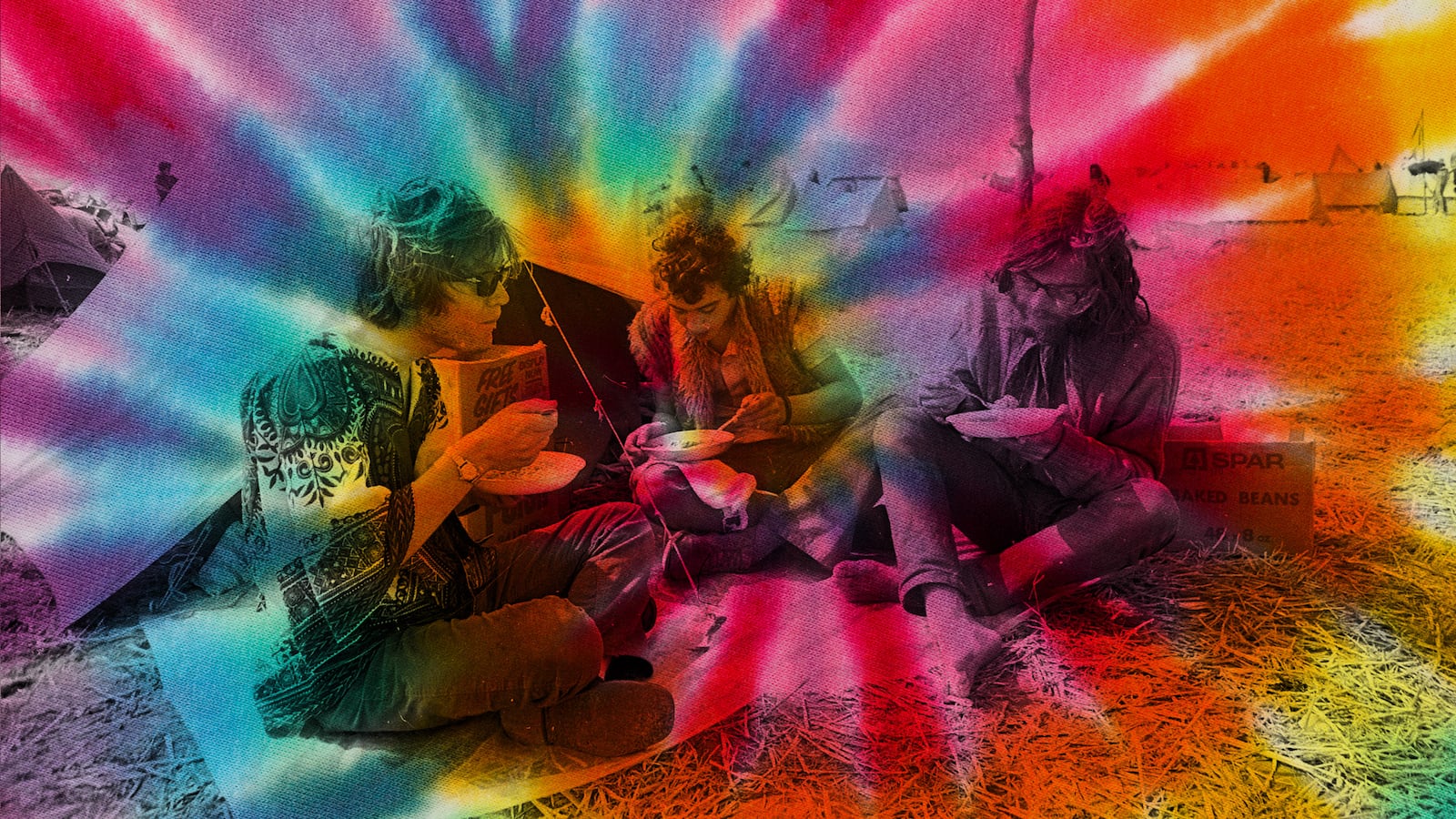Cubes of sweet potato and U’s of celery bob on the surface of a chunky “Mexican bean fiesta soup,” the scent of cumin surfing on the steam rising off its surface. Alfalfa sprouts jut out of an avocado Havarti sandwich as if its toasted whole-wheat shell were a squashed-on hat. A side salad is drizzled with tahini-lemon dressing and speckled with sunflower and sesame seeds. Tack on a slice of nutloaf, and you’d have a complete 1970s feast, the antithesis of all-American meat and potatoes, the kind of food that would still be associated with hippies even 50 years after San Francisco’s Summer of Love.
The Sunlight Cafe, opened in 1977, doesn’t deny its hippie heritage. Although Seattle’s climate often renders its name aspirational, when the sunlight does arrive it floods the brightly colored room. Native American paintings hang above the wooden booths, and solid-looking whole-wheat cookies and muffins lurk in the pastry case. The sign on the men’s bathroom depicts a stringy-haired, bell-bottomed dude. I share the same scuffed wood table with several white guys in their 60s reading the Seattle Times over their huevos rancheros and a group of stout, fleece-clad women debating whether they’re going to order the tempeh or the tofu burger because both sound “soooo good.”
These are my people. This is the food I have been surrounded by all my life.
For those of you who didn’t grow up eating lentil and brown-rice casseroles, it may be hard to recognize what came to be called “hippie food.” That’s because so many of the ingredients that the counterculture of the 1960s and 1970s adopted, defying the suspicion and disgust of the rest of the country, have become foods many of us eat every day.
The organic chard you bought at Kroger last week? In the early 1970s, farming organically was considered a delusional act. The granola-yogurt parfait your coworker just picked up at Starbucks? In 1971, both granola and yogurt were foreign substances, their reputation as tied to long-haired peaceniks as pourover coffee is to lumberjack beards and high-waisted jeans. Back then, whole-wheat bread had disappeared from grocery stores. Hummus wasn’t a childhood staple but a dish only spotted in Middle Eastern markets and vegetarian cafes.
The cuisine that the counterculture took to in the late 1960s, and then helped introduce to the mainstream in the 1970s, embraced whole grains and legumes; organic, fresh vegetables; soy foods like tofu and tempeh; nutrition-boosters like wheat germ and sprouted grains; and flavors from Eastern European, Asian, and Latin American cuisines. The food young bohemians concocted with all these ingredients was often vegetarian, sometimes macrobiotic, and occasionally inedible.
Much of what my friends and I grew up eating in the 1970s had all the characteristics that still define hippie food to me, like oatmeal whole-wheat bread, homemade yogurt sweetened with a spoonful of my mother’s own jam, date-pecan granola, West African ground-nut stew, and vegetables pulled from our garden–grown without pesticides or herbicides, of course.
So I ask with all earnestness: How can you not love an avocado-havarti sandwich? The gush of the ripe avocado. The crunch of the toasted bread. The intense green flavor of the alfalfa sprouts, which smell as if a field of grass were having sex. To me, lunch at the Sunlight Cafe evokes the same warm-blanket comfort that macaroni and cheese does for other Americans. Lunch here isn’t satisfying in the same way that a well-charred steak is. But it’s satisfying none the same: earthy, fresh, and none too complex.
Fifty years on, it may seem inconceivable how revolutionary a stir-fry of tofu and vegetables over brown rice could be in 1967 and how alienating a Havarti and avocado sandwich on whole-wheat bread would have seemed to most Americans.
Although the 19th century and early 20th century saw the invention of canning, freezing, and other methods of processing food, World War II marked a turning point in American manufacturers’ ability to manipulate our food into forms never seen in nature. Out of the war came the technological processes to produce dried soup powders and pudding mixes, salad oils, canned fruit juices, and ready-to-eat meals. Out of the war, too, came 65 approved pesticides, including DDT, invented by scientists researching nerve gases—a fortuitous accident, you might say.
Those advances merely set the stage for a post-war boom in agriculture, food manufacturing, and retail.
The food Americans were eating in the mid 1960s resembled nothing that any civilization on earth had ever eaten before. The United States out-right manufactured a meal like the Dining Deck Supper—through innovations in farming, food processing, flavoring, packaging and, yes, marketing, as well as a queer eagerness to abandon the culinary wisdom of the generations that preceded them.
The same might be said of 1970s hippie food.
It is impossible to talk about this Esperanto of a cuisine without talking about the conversation around food that shaped it. In the late 1960s and early 1970s, food came to mirror the fears of a generation of young Americans as well as their idealism. Hippie food was a rejection—of all the forces that created Wonder Bread and TV dinners—as much as it was an embrace of new ingredients and new flavors. Eating brown rice was a political act, just as wearing your hair long or refusing to shave your armpits could subject you to ridicule and harassment.
The food the counterculture embraced had to be grown differently, sourced differently, cooked differently. Like a sestina, perhaps, the series of strictures cooks had to observe—no pesticides, no flavorings, no packages, no refined sugars or grains, and for some, no meat—was more important, at first, than the taste of the meal. Ingredients had to arrive in the kitchen as close to the form they were pulled out of the fields as possible.
Young Americans wanted to strip their cuisine back to its pre-industrial roots. And then, as they tried to figure out what they should eat instead of military-industrial trash, a reactionary generation sought council from the fringes. They found it in health food faddists, rogue nutritionists, mystical German farmers, Japanese dietary prophets, and nameless cooks from countries their parents had barely dreamed of visiting. That Harvard nutritionists or newspaper journalists thought these sources were all bunkum only validated that the counterculture was on the right track.
This movement was taking place, simultaneously, in every state of the land. Of course, big cities such as San Francisco, Seattle, Boston, Los Angeles, Chicago, and Minneapolis, famous for their hippie enclaves, were home to businesses and publications that reached the entire country.
Smaller college towns were vortexes of influence, too, culinary paradises if you had certain tastes in food. Take, for instance, Ann Arbor, home of the University of Michigan. By 1977, a section of its downtown was home to the People’s Food Co-op, an herb and spice collective, the whole-grains Wildflour Bakery (which also housed the Grainola Collective), and the Soy Plant. Nearby was Eden Foods, a macrobiotic wholesaler and retail store. Vegetarian restaurants like Indian Summer and Seva both thrived close to campus. Many of these enterprises were getting wholesale goods from the collectively run People’s Wherehouse and its collectively operated grain mill. And if you showed up at the Ann Arbor Farmers’ Market on a weekend, you’d spot Frog Holler Farms, a tribe of back-to-the-landers who were calling their vegetables and greens “organic.”
But the movement expanded, almost instantly, beyond those cultural hubs. Longhairs didn’t need the Internet. They had word of mouth. Reared on protests and community organizing, schooled on political discourse, committed to the consensus decision-making that would turn every meeting into a four-hour debate, they talked and talked and talked and talked this diet into existence.
And once they talked it into existence, they had to figure out how to make it taste good.

From the book Hippie Food: How Back-to-the-Landers, Longhairs, and Revolutionaries Changed the Way We Eat by Jonathan Kauffman. Copyright © 2018 by Jonathan Kauffman. Reprinted by permission of William Morrow, an imprint of HarperCollins Publishers.






